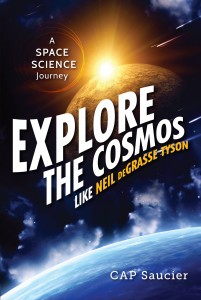
By Terri Schlichenmeyer
The Bookworm Sez
Nighttime is absolutely your favorite time.
Some people choose to hang out with friends after dark. Some go to movies, listen to music, or just go to sleep. But you – as soon as it’s dark, you lay down somewhere quiet and look up. That’s where the stars are, and in the new book by CAP Saucier, you can learn to “Explore the Cosmos like Neil deGrasse Tyson.”
Born a few days before the National Aeronautics and Space Administration began, Neil deGrasse Tyson likes to say he’s the same age as NASA. By the time he was nine years old, he was “in love with the night sky” and at eleven, he knew he wanted to be an astrophysicist (a scientist that studies the universe). He was so fascinated by planets and stars that he almost got in trouble with a telescope when he was a teenager.
Tyson’s parents both stressed to him that skipping college was not an option and so, though he wasn’t a great student in high school, Tyson went to Harvard, then to the U of Texas and to Columbia University. Why, you might ask, didn’t he become an astronaut? Back then, the program wasn’t open to African Americans, so being an astronaut never even entered his mind.
In finding beauty in the night sky, Tyson is not alone.
More than 2,500 years ago, the Greeks looked upward and tried to understand what they saw. Other cultures studied the heavens, too; Ptolemy tried to count the stars, and stopped at a thousand. In recent years, we’ve learned more about the cosmos than ever before, but there’s still so much we don’t know.
To study the stars, you need to understand light and physics. You’ll need to know about
galaxies and Nebulas, which look different and have descriptive names. You’ll want to find out the truth about black holes, and why you never, ever want to be “spaghettified.”
And above all, says Tyson, stay in school, learn math, and go for the best education you can get. Even if you don’t end up studying stars, that’s always a good path to take.
I was pleasantly surprised and a little daunted, both, by “Explore the Cosmos like Neil deGrasse Tyson.”
The delight comes in the biography part of this book. Author CAP Saucier lets us explore the life of Neil deGrasse Tyson, from his childhood to his fascinating career today and what he thinks about the future of space exploration. Along the way, we’re given an education on the universe and what’s in it.
That part, however, can be formidable; the language is more advanced than I would have liked to see in a book for middle-graders. Kids who tackle those sections will need a better-than-average understanding of astroscience, since those pages aren’t otherwise very kid-friendly.
I think maybe a science-loving 9-year-old could try this book but it’s really better-suited for someone older. For a sharp child with her head in the stars, “Explore the Cosmos like Neil deGrasse Tyson” is pretty cosmic.




